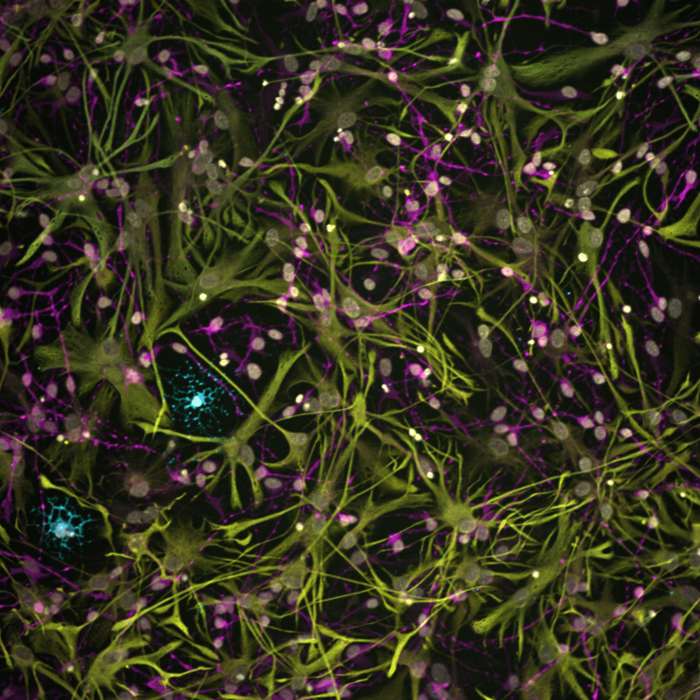Researchers from The New York Stem Cell Foundation (NYSCF) Research Institute and Case Western Reserve University have discovered novel ways in which glia, by using the largest known collection of stem cell models from MS patients, essential brain support cells contribute to the disease.

Image Credit: The New York Stem Cell Foundation
The research, which was published in the journal Cell Stem Cell, is the first to show that glial cells from MS patients have intrinsic disease hallmarks that are unaffected by the immune system. This finding highlights the potential of stem cells to uncover new disease biology and highlights the need for novel MS treatments.
The immune system of the body unintentionally targets the myelin sheaths that encase the nerves in the brain and spinal cord in multiple sclerosis (MS), an inflammatory disease that causes severe neurological impairment.
Most research and therapeutic strategies have so far focused on blocking the overactive immune system, but how cells in the brain itself, especially glia, contribute to the initiation and progression of MS remained a mystery.”
Valentina Fossati, PhD, Study Lead and Senior Research Investigator, The New York Stem Cell Foundation
The group produced the biggest collection of MS patient stem cell lines to date, spanning a variety of clinical subtypes, by utilizing the NYSCF's automation systems to generate induced pluripotent stem cells (iPSC) from skin biopsies of MS patients. After that, they transformed the iPSCs into glial cells, which comprise astrocytes and oligodendrocytes, to study their function in the illness.
By generating glia-enriched cultures from stem cells, we have been able to study their role in MS independently of the complex environment in the body, which is constantly altered by the presence of immune cells and inflammatory signals.”
Valentina Fossati, PhD, Study Lead and Senior Research Investigator, The New York Stem Cell Foundation
The researchers discovered that stem cell-derived glia cells from patients with primary progressive MS—a particularly severe form of the disease—contained fewer oligodendrocytes through the use of single-cell gene expression profiling. Myelin, the sheath that surrounds nerve fibers and is destroyed in multiple sclerosis, is made by oligodendrocytes.
This observation challenges the conventional understanding of MS as being purely driven by immune system dysfunction, suggesting that the disease may also be fueled by processes originating within the brain itself.”
Paul Tesar, PhD, Study Co-Lead Author, Dr. Donald and Ruth Weber Goodman Professor of Innovative Therapeutics, The New York Stem Cell Foundation
Paul Tesar is also the Director of the Institute for Glial Sciences at Case Western Reserve University School of Medicine and NYSCF – Robertson Stem Cell Investigator Alumnus.
Additionally, the researchers noticed that glia cultures produced from stem cells from MS patients had a notably active set of genes linked to immunological and inflammatory processes, which is consistent with the activity of these genes in brain samples from MS patients who have passed away.
Furthermore, NYSCF researchers used the most recent developments in artificial intelligence to identify astrocyte variations that are difficult for the human eye to discern.
“The fact that glia created from stem cells show similar features to glia in MS patient brains shows us that stem cell models provide a pretty accurate reflection of what happens in the brains of living patients, and that we can use them to gain important insights into this disease,” added Dr. Fossati.
A New Target for Therapeutic Intervention
Many MS treatments now target the immune system due to the disease's autoimmune component. Unfortunately, these medications are not effective in stopping the neurodegeneration that propels the advancement of sickness; rather, they only assist in lessening the frequency of immune attacks.
The results of the study provide new avenues for MS treatment. Researchers can now investigate new treatments that specifically target these cells after identifying particular characteristics of glial cells that are linked to the disease. This may result in more potent therapies that give patients hope again by doing more than just suppressing the immune system.
“Our findings represent a significant leap forward in our understanding of MS and underscore the vast potential in glia as a target for therapeutic intervention that could transform the treatment landscape for many patients,” remarked Dr. Tesar.
Breakthroughs Enabled by Team Science
This research was made feasible by the potent union of the Tesar lab's proficiency in researching glia in neurological disease and creating novel medications with NYSCF's exceptional capacity for large-scale stem cell-based disease modeling.
Working together with Ilana Katz Sand, MD, Associate Director of the CGD Center for MS, and Patrizia Casaccia, MD, PhD, who is currently Director of the Neuroscience Initiative of the Advanced Science Research Center at the CUNY Graduate Center, patients were recruited at the Corinne Goldsmith Dickinson Center for Multiple Sclerosis.
Jennifer J. Raab, NYSCF’s President and CEO said, “This study is a remarkable example of team science. It is through unique collaborations like these that we can move even faster towards new treatments for the major diseases of our time that patients urgently need.”
Source:
Journal reference:
Clayton, L.L. B., et al. (2024) Patient iPSC models reveal glia-intrinsic phenotypes in multiple sclerosis. Cell Stem Cell. doi.org/10.1016/j.stem.2024.08.002.